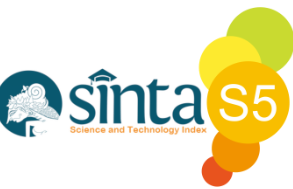Abstract
Iodine is an essential nutrient for the human body. It is required by the thyroid gland for producing the thyroxine hormone. Human body lacks the ability to self-produce iodine. Some sources of iodine in food such as seafood, milk, egg, fruits, and vegetables can be consumed to fulfill the daily needs. Table salt is one of the sources of iodine that is routinely consumed. According to SNI No. 3556:2010, table salt must be fortified with 30–80 ppm of potassium iodate. Lack of iodine intake results in a disorder known as the iodine deficiency disorder, which is generally manifested as mumps. This study analyzed the content of iodate in table salt based on the formation of the blue I2–starch complex. Several optimum conditions were used for this measurement, such as the maximum wavelength, the type and concentration of acid, and the stability time of the complex. Based on the analysis of commercial table salt samples, the results showed that only 50% of our samples contained an appropriate amount of iodine, whereas the remaining samples contained lower or almost no iodine content.
Bahasa Abstract
Yodium merupakan nutrisi penting bagi tubuh manusia. Hal ini diperlukan oleh kelenjar tiroid untuk menghasilkan hormon tiroksin. Tubuh manusia tidak memiliki kemampuan untuk memproduksi yodium sendiri. Beberapa sumber yodium dalam makanan seperti makanan laut, susu, telur, buah-buahan, dan sayuran dapat dikonsumsi untuk memenuhi kebutuhan sehari-hari. Garam meja adalah salah satu sumber yodium yang dikonsumsi secara rutin. Menurut SNI No. 3556: 2010, garam meja harus diperkaya dengan 30–80 ppm potasium iodat. Kurangnya asupan yodium menghasilkan gangguan yang dikenal sebagai gangguan defisiensi yodium, yang umumnya dimanifestasikan sebagai gondong. Penelitian ini menganalisis kandungan iodat dalam garam meja berdasarkan pada pembentukan kompleks biru I2-pati. Beberapa kondisi optimum digunakan untuk pengukuran ini, seperti panjang gelombang maksimum, jenis dan konsentrasi asam, dan waktu stabilitas kompleks. Berdasarkan analisis sampel garam meja komersial, hasilnya menunjukkan bahwa hanya 50% dari sampel kami mengandung jumlah yodium yang tepat, sedangkan sampel yang tersisa mengandung lebih sedikit atau hampir tidak ada konten yodium.
Recommended Citation
Wulandari, Eka Ratri Noor and Rosyida, Novita
(2017)
"Analysis of Iodine Content in Table Salt,"
Jurnal Vokasi Indonesia: Vol. 5:
No.
1, Article 5.
DOI: 10.7454/jvi.v5i1.84
Available at:
https://scholarhub.ui.ac.id/jvi/vol5/iss1/5
Included in
Accounting Commons, Arts Management Commons, Business Administration, Management, and Operations Commons, Business Analytics Commons, Educational Administration and Supervision Commons, Insurance Commons, Tourism and Travel Commons








